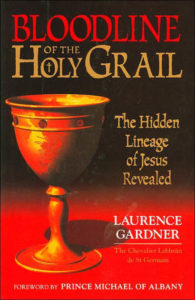
What faulty thinking twenty years ago compelled me to pick up this doorstop is lost to me today. With no reading material on hand, in a Munich airport bookstore and facing a direct flight back to the United States, I probably thought Laurence Gardner’s beefy Bloodline of the Holy Grail (1996) was making the best of a bad situation.
Airport bookstores and newsstands are, by and large, a waste of time for me. Most of them stock novels riding high on the New York Times bestseller list, self-help guides, business books for business people looking to maximize their potentialities, and a smattering of classic thrillers perpetually in-demand. (The Girl with the Dragon Tattoo books seem to fit this last category.) I rarely find a book worth reading among their stacks, but that hasn’t stopped me when I’m desperate for a way to pass this time midair.
Bloodline of the Holy Grail fits the bill as a long-flight read due to its sheer bulk. Chewing through its four hundred and fifty pages to pass the time on a red-eye is a solution…assuming you’re willing to suspend critical thought and rational consideration.
Bloodline is a repackaging of the more widely known Holy Blood, Holy Grail (1982), the sprawling pseudo-historical conspiracy theory disguised as academic research. The bare-bones outline of Holy Blood, Holy Grail was lifted by Dan Brown as background for his thriller The Da Vinci Code (2003), which resulted in a lawsuit against Brown. Laurence Gardner undoubtedly cribbed Holy Blood for Bloodline as well, although toward different ends.
The three books are premised on the idea that Jesus did not die on the cross, but was rescued by his followers and resuscitated without the knowledge of his Roman executors. The notion of Jesus surviving his crucifixion is not new. What’s new is to weaponize it into an attack on these books’ favorite targets. In the case of Holy Blood, it’s the Catholic church. In the case of Bloodline, it’s the British royal family.
According to both books, Jesus survived his crucifixion, married Mary Magdalene, raised a family, and anonymously died of natural causes. Mary and children sailed to France and established what became the Merovingian dynasty—that is, the foundation for all major royal lineages in Western European. You read that right.
Bloodline spins out of control from there, as though it wasn’t reeling fast enough. To connect Jesus’ bloodline to the major European monarchies, Gardner rewrites two thousand years of Western history with a horse-breeder’s attention to genealogy. He even injects into his pseudo-history figures of Biblical and Arthurian legend, presenting them as living, breathing persons instead of the fiction they are. The Holy Grail on the cover of the book? Gardner drops the canard where the word San Greal (Holy Grail) is a corruption of Sang Real (royal blood), another longstanding bunk theory unsubstantiated by the historical record.
Up to this point Bloodline tracks closely to Holy Blood, Holy Grail. I was not aware of the latter book when I was on my flight, and The Da Vinci Code had yet to be published. Although I bought into none of Gardner’s hogwash, I was thoroughly impressed with his conviction and persistence. It’s much like Oliver Stone’s JFK, another ripping yarn I relish in repeated viewings whilst my intellect whispers in my ear: Factually, this is all crap. When Da Vinci Code became a hot ticket, I was convinced Dan Brown had ripped off Laurence Gardner, not knowing Gardner had, in turn, ripped off the earlier source. Lots of pigs have fed at the trough of Holy Blood, Holy Grail.
On my flight I found myself thumbing ahead, skipping page after page of Gardner’s tedious and picayune revisionism. Like the high-minded JFK conspiracy theory books of the 1970s, Bloodline is chock full of footnotes and references to historical research. And, like those JFK conspiracy books, the tornado of references serves to obscure the questionable, if not dishonest, interpretation of that material.
Bloodline comes to a crashing conclusion when it declares the current royal family of Britain are illegitimate throne-bearers. Gardner announces the proper King of Scotland (and direct descendant of Jesus Christ!) is HRH Prince Michael James Alexander Stewart, a Belgian named Michel Lafosse who contends he’s the head of the Royal House of Stuart, a lineage otherwise considered extinct. With only a few more pseudo-historical yoga poses, Gardner proves Lafosse should be the King of England as well.
That’s it. This entire four hundred fifty page book is an argument claiming some bloke is the rightful occupant of Buckingham Palace. Gardner concludes with a frosty condemnation of democracy and pining for return to a proper constitutional monarchy.
Author Laurence Gardner liked titles almost as much as Lafosse. Gardner was “Chevalier Labhran de St. Germain” and “the appointed Jacobite Historiographer Royal”—all bestowed upon him by Lafosse, who also showered invented titles on himself. The moment one learns of this incestuous relationship between the pretender king and his genealogist, the ulterior motivations behind this turd of a book crystallizes before your eyes. The Guardian scoffed at this circle jerk of title inflation as a “web of imposture,” an elegant phrase to describe a sad and delusional fraud.
Bloodline of the Holy Grail is the most exhausting shaggy dog story I’ve ever read (and I’ve read Tristram Shandy, the shaggiest of them all). It may also be the most ambitious vanity project ever mounted. To plow through so much dense mud and be handed such a smelly egg in the final pages almost led me to throw the book out the plane window as we were landing.
Still, Bloodline stands as the missing link between Holy Blood, Holy Grail and The Da Vinci Code—a historical thriller presented as dry fact, opening in the ancient Holy Lands with a botched crucifixion, and culminating with a modern-day secret king denied his crown. If Gardner had been more entrepreneurial-minded and abandoned his penchant for toffee-nosed honorifics (“Prior of the Sacred Kindred of St. Columba”? “Attache to the Grand Protectorate of the Imperial Dragon Court, 1408”?), he could have pumped Bloodline into a full-blooded 1990s thriller and beaten Dan Brown to the winner’s circle by nearly a decade. After all, the public has shown a bottomless appetite for Bible conspiracies and Holy Grail histories. How many metric tons of trees have been ground to pulp to distribute this sort of crap worldwide?
Recommended for a long flight? Go reread The Girl with the Dragon Tattoo instead. Better yet, read Kazantzakis’ The Last Temptation of Christ to involve yourself in the life of a Jesus more fragile and human than any conspiracy writer could devise.
